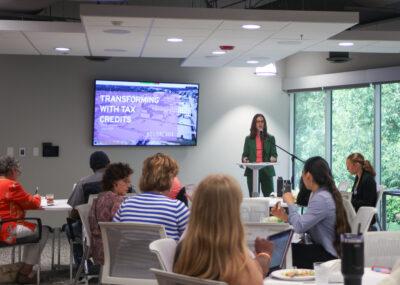LANCASTER, S.C. — Last week, the Arras Foundation hosted a tax credit education lunch and learn for community members interested in learning about property development incentives. Heather Mitchell, president of Columbia-based architecture firm BOUDREAUX, presented to nearly 50 people about various tax incentive programs that individuals or companies can utilize to bring their projects to life.
“Transforming With Tax Credits.” The title of Mitchell’s presentation was the perfect descriptor for the information shared. Federal and state historic rehabilitation, abandoned building, and textile mill tax credits, as well as the Bailey Bill and façade easements, were all discussed as applicable and attainable financing options for projects in the Lancaster and Chester area.
“I know first-hand the trials, tribulations, and joys that ultimately come from adapting, reusing, and rehabilitating historic buildings and what they can do for communities,” said Mitchell, when referring to her own office building in downtown Columbia that was redeveloped using historic tax credits. Her own owner-architect-developer project now includes a successful boutique hotel, the Hotel Trundle, which is attached to the BOUDREAUX office.
While tax credits, specifically ones that involve historic preservation, must follow strict guidelines from the State Historic Preservation Office (for state historic tax credits) and the National Park Service (for federal historic tax credits), these incentives ultimately help close large financing gaps and provide financial incentive to invest in the redevelopment of historic properties.
While maintaining the unique historic character of buildings in redevelopment is required for using tax credits, these characteristics also typically end up being part of the marketing and draw for the public at project completion. The Hotel Trundle is a great example of this — each hotel room has a unique design based on where it is in the building, and that part of the building’s historic use, which draws visitors back to the hotel for a chance to see each different space.
How might an individual know which tax credit program would offer the best value in a project? The short answer, according to Mitchell, is to work with preservation consultants or attorneys who have experience in advising historic redevelopment projects. These tax incentive programs can also be used together and layered on top of one another to provide more income to the project, with a few exceptions.
Buildings that are not currently on the state or federal historic register, but are at least 50 years old, may be eligible to be added and then eligible for tax credits.
“All of this takes time; this process is a labor of love and patience,” Mitchell reminded the crowd. From project idea to fruition and all of the steps in between, historic revitalization projects typically take many years.
The Arras Foundation has been supporting local revitalization efforts since 2016 and is proud to continue bringing shared learning and other resources to support our community’s development.
If you are interested in learning more about tax credits, the Tax Credit Education Lunch & Learn was recorded. Please email the Arras Foundation at info@arrasfoundation.org if you would like to access this information.
This article was first published in The Lancaster News.

